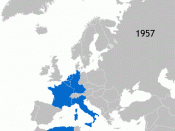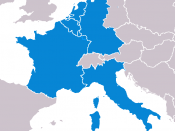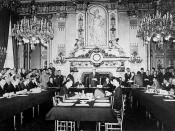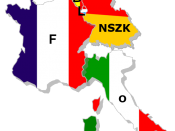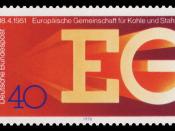How did the Franco-German alliance promote the idea of the European Community and the Union ? INTRODUCTION.
For hundreds of years, Europe has always been in internal turmoil. Maybe it's because of language barriers, religion, historical events, of differences in politics, the economy or even culture; no-one knows for sure. What we do know is that this constant bickering has led to two devestating world wars, claiming millions and millions of lives, and that, since the end of the second war, things have gone fairly well. There has not been a world war in over 50 years and co-operation between States has never been better. But what was the cause for such a dramatic change ? Many answers may come to mind but anyone one them will have the same origin, that is the co-operation between France and West Germany. The following will try to identify how exactly did the Franco-German alliance help promote the idea of a united Europe and the Creation of the European Union (EU), by looking back at the first co-operation between the two, the European Coal and Steel Community (ECSC), how it led to the creation of the European Economic Community (EEC), to eventually become the European Union.
EUROPEAN COAL AND STEEL COMMUNITY.
The man responsible for concocting this idea is a man by the name of Robert Schuman, the French Foreign Minister from 1948 to 1953. He announced his plan in 1950, a plan which he said was " the first step in the realisation of a vision, a vision of a united Europe which would have Franco-German reconciliation at its heart." To put it simply, the Scuman Plan as it was called, would unite countries into an alliance in which all customs barriers against the trade of coal and steel would be abolished to create a commun market for these products, and at the same time, would improve relations between France and Germany if the latter accepts the alliance.
The choice of the coal and steel industry made sense because these two sectors were the most important economic sectors at the time, coal being the prime source of energy. This was to be more than a simple free trade agreement because the attainment of common measures in politics depended on mutual agreements between States.
In April 1951, the Treaty of Paris was signed by representatives of the six founding members, France, Germany, Italy, Belgium, the Netherlands and Luxembourg, an agreement that created the European Coal and Steel Community (ECSC), an organization that would start its operations in July 1952. The founders of the ECSC had two basic set of objectives to attain by the creation of this body, objectives that went far-beyond the industry of steel and coal.
The first ECSC objectives were evedently economic. The steady stream of inexpensive steel and coal would help rebuild economies and countries devestated by the Second World War, by creating a system of free competition that would allow costs and prices to be lowered, thus creating a common market for the countries, within which the two industries would be concentrated in the hands of the most efficient producers through the elimination of trade restrictions and the free movement of resources. The long -term economic goal of the ECSC was to help Western Europe regain its dominance in the international steel market.
The other set of objectives was a bit more political. The ECSC was conceived by France as a confidence-building mechanism between Germany and itself, and as a compromise between the two, France haven given up a part of its sovereign power in order to secure a degree of international control over German coal and steel. The ECSC was even proclaimed as a solution to the long-standing political problems posed by Franco-German relations; there was hope that the common market would encourage a spirit of, not only economic, but political co-operation between the two countries. Schuman was even quoted as saying that " the solidarity in production thus established will make it plain that any war between France and Germany becomes not merely unthinkable but actually impossible." The French also saw this treaty as an opportunity for a "rapprochement" with Germany, and as a chance to establish its leadership in Europe. So this association was more of a political one than an economic one.
Another thing to look forward to from the ECSC was the prospective of a united Europe, the Schuman Plan being the first step of this process, which has then led to the creation of other organizations such as Euratom and the European Economic Community (EEC), organizations that have later on helped to create the European Union (EU).
After agreeing on what the community's objectives were, the six countries in question established four main institutions that would compose the ECSC: the High Authority, the Counsil of Ministers, the Common Assembly and the Court of Justice. These governing bodies were to promote greater average productivity or efficiency in the coal and steel industry, and/or to reduce costs by means of greater regional specialization in the most avantageous producing districts. In other words, tarifs had to be lowered to facilitate movement in Europe by " establishing conditions which would themselves ensure the most rational distribution of production at the highest possible level of productivity, by safeguarding continuity of employment and avoiding the creation of fundamental and persistent disturbances in the economies of the member States." The first and most important of these four bodies, the High Authority, is the executive body. This institution is composed of nine members representing each of the six countries. It has the power to stimulate competition, to suppress restrictive and predatory trade practices, and to inflence and coordinate investment in such a way as to ensure a national supply and a growing output of coal and steel. It's the High Authority's responsability to create the necessary measures needed to properly administer the common market.
The second and third institutions, the Counsil of Ministers and the Common Assembly, both represent national sovereignty, democracy and equality between nations, each in their own way; the Counsil looking closely at the relations between the High Authority and the States to make sure that things run smoothly (more importantly, to make sure that the High Authority doesn't abuse its powers), and the Assembly doing its part by advising and criticizing the Authority because it basically has very little power to do anything else.
As for the fourth body, it was so important that it later had a trumendous role towards European integration. The Court of Justice was created to resolve problems between member States, or between levels of the ECSC, and had the power to act on its decisions. The Court was so successfull at doing its job that in the following years, its jurisdiction was expanded to include other agreements, and now rules over the European Economic Community, which has now become the European Community.
Up to this point, it can be said that the ECSC had been a reflection of the changing world economy and the first realization that if you want to compete on the the world market, you have to become bigger. This was the start of the scale economy.
The ECSC also gave France a chance to get rid of their doubts towards Germany, which they did, and that brought them closer together in a political sense and in an economic sense as well. From that moment on, the relationship between the two countries propelled them to become the locomotives of their continent, that influencing the other European countries. But in order to fully understand the extent of the Franco-German alliance on the European Union, we must now briefly take a look at what arose from the ECSC; the European Economic Community.
EUROPEAN ECONOMIC COMMUNITY.
The year 1957 saw the six member countries of the ECSC sign the Treaty of Rome, which was the Constitution of the EEC, a union that would hopefully provide economic and political integration to Europe, which the ECSC didn't because it was limited to only one sector. But to provide this, tarifs had to be lowered and trade barriers had to be eliminated (these measures also had to conform to the GATT - General Agreements on Tarifs and Trade). Once that was done, other goals had to be achieved; end price fixing, limit production in some areas in order to keep prices high, end subsidies, and coordinate economic and monetary policies as well. And as a matter a fact, most of them were.
Furthermore, the EEC, unlike the ECSC , included non-economic dimensions such as social policy and agicultural policy, both of which being signs of compromises between France and West Germany; since Germany would probably benifit from the open markets of a new customs union, France asked and got an Atomic Emergency Community (EURATOM, which came into effect at the same time as the EEC) which would make it more energetically independent, protection of the Frech farming and agricultural industry, and "privileged relations with the six (founding countries) for its overseas dependencies." Again, this step forward in the advancement of the negotiations for the EEC could not have been possible if it wasn't for France and Germany working together.
The EEC has also led to the creation of a European Bank (similar to the World Bank) and of a European Development Fund, which exclusively helps over-seas territories.
Last but not least thing I want this Community influenced of the ECSC was so present in its creation that four of its governing bodies are all based on ECSC institutions (the two communities are also ruled over by the same Court of Justice). It is this ECSC that influenced Economic Community that has led to the European Community and the European Union that we know today.
CONCLUSION.
Things have moved a long way since the end of the Second World War. It must have been impossible at the time to predict that France and Germany would one day unite in order to sign a pact creating a coal and steel community, which 40 years later, would lead to a Treaty regrouping ten other European States to form an alliance. Well this is what happened when the Treaty of the European Union (TEU) was signed by representatives of Belgium, Denmark, Germany, Greece, Spain, France, Ireland, Italy, Luxembourg, the Netherlands, Portugal and the United Kingdom, in February 1992. The European Union subsequently took effect on November 1ST 1993.
This European Union is probably what Robert Schuman was thinking about when he said that the ECSC was only the first step, and it's a credit to his vision that it has been France and Germany which have been moving the European Community forward for, at least the last 20 years. Let's not forget that without a Franco-German alliance, there would never have been an ECSC, or an EEC, or an European Union for that matter. By compromising with each other, France and Germany have brought Europe into the 21ST century through economic, social and political integrations that have spread through out the continent. Through the ECSC, Europe had its first taste of what we now call the world economy and the world market.
It's also the axes of political action created by Germany and France in the 1970's that has emphasized the importance of summitery to its European counterparts, showing at the same time their own commitment to the Union. Who know's what might have become of the European Economy if it wasn't for the Schuman Plan and for the co-operation that it brought ? Many people may not like the French, but for this once, they had the right idea.
BIBLIOGRAPHY.
- Bok, Derek Curtis, The first three years of the Schuman Plan, New Jersey, Princeton University Press, 1955.
- Heckscher, August, Europe's Coal & Steel Community, New York, The Twentieth Century Fund, 1960.
- Nugent, Neill, The government & politics of the European Union, Durham, Duke University Press, 1994.
- Treaty establishing the European Coal & Steel Community, England, Her Majesty's Stationary Office, 1951.
